Faucet Material
Introduction — Why Faucet Material Matters More Than You Think
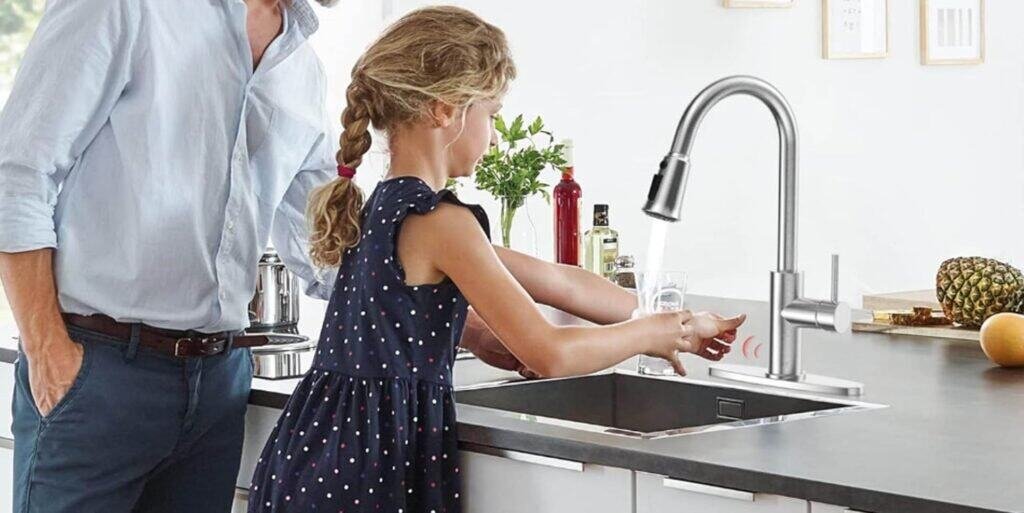
When choosing a faucet, most people focus on design, color, or price. However, the faucet material you choose has a far greater impact on performance, durability, and long-term value. Whether for home renovation or a commercial project, the core material determines how well a faucet resists corrosion, maintains water quality, and stands the test of time.
For B2B buyers and distributors, understanding faucet materials isn’t just a technical detail—it’s a business decision. The wrong choice can lead to frequent warranty claims, customer complaints, or early product failure. In contrast, selecting the right brass faucet, stainless steel faucet, or zinc faucet can build trust, reduce costs, and enhance your brand reputation.
A faucet’s body is more than its appearance. Beneath the finish lies the true heart of durability—the metal or material used in its construction. In this guide, we will explore the strengths and weaknesses of each type, explain how they perform under real-world conditions, and show how to choose the most durable faucet for your needs.
Understanding Faucet Material Basics
Before diving into specific materials, it’s essential to understand what “faucet material” really means. Every faucet has a body, cartridge, and finish—and the body material plays the most critical role in its overall lifespan. The faucet body connects all the internal parts, manages water pressure, and resists corrosion over years of use.
There are four main categories of faucet materials in today’s market: brass, stainless steel, zinc, and plastic. Each comes with unique advantages, cost structures, and performance levels. Let’s take a closer look at how these materials affect quality, weight, and durability.
1. Brass Faucets

Brass is an alloy of copper and zinc, known for its excellent corrosion resistance and mechanical strength. Because of its density, a brass faucet feels solid and heavy, symbolizing quality and durability. It can handle years of use without significant wear, making it a top choice for both residential and commercial projects.
However, brass can contain small amounts of lead, which is why modern manufacturing standards—such as NOM-012-CONAGUA in Mexico and NSF/ANSI 61 in the United States—require lead-free formulations. Lead-free brass is now a global standard for safe water usage.
2. Stainless Steel Faucets
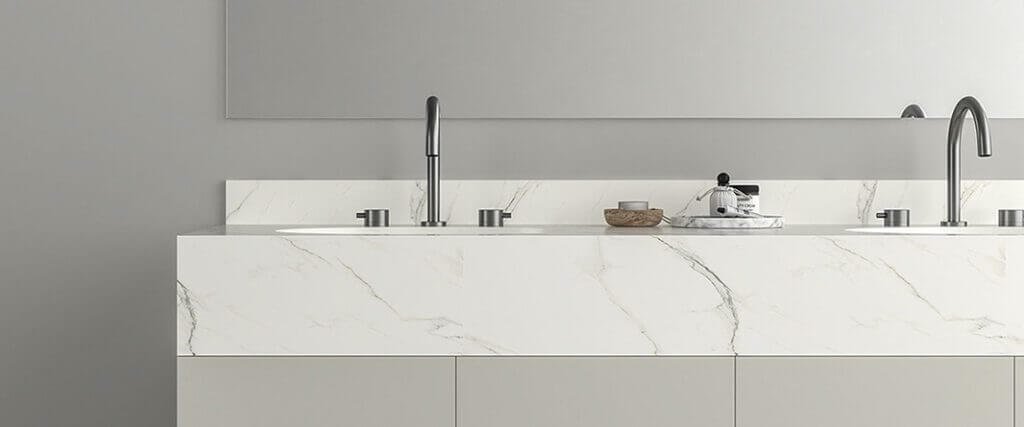
Stainless steel faucets are widely used for their clean, modern appearance and excellent hygiene properties. Stainless steel resists rust and scaling, making it ideal for kitchens and high-humidity environments.
Among the available grades, 304 stainless steel offers superior durability and corrosion resistance, while 201 stainless steel is more affordable but less resistant to harsh environments. Choosing between these two depends on your target market and project requirements.
3. Zinc Faucets
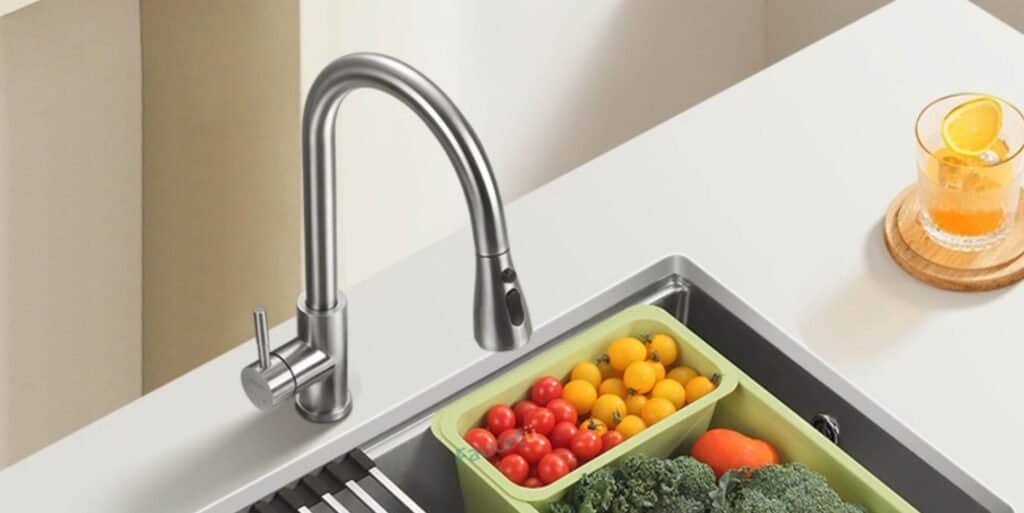
Zinc faucets are often chosen for their low cost and smooth casting finish. They are lighter than brass or stainless steel, making them suitable for budget-friendly applications. However, zinc’s corrosion resistance is limited, so these faucets are best for short-term or decorative use rather than heavy-duty projects.
Zinc faucets serve a purpose in certain B2B markets—especially for rental housing, low-cost projects, or short-term installations—but they are not designed for decades of use.
4. Plastic Faucets
Although not common in high-end markets, plastic faucets (usually made of ABS or PVC) offer advantages in cost and corrosion resistance. They are lightweight and easy to install, but they cannot match the pressure resistance or longevity of metal faucets. These faucets are mainly used in temporary facilities or lightweight portable systems.
Comparing Faucet Materials at a Glance
Material | Corrosion Resistance | Durability | Weight | Cost | Typical Use |
Brass | Excellent | 20+ years | Heavy | $$$ | High-end residential, hotels |
Stainless Steel (304) | Very Good | 15–20 years | Medium | $$ | Kitchens, commercial |
Stainless Steel (201) | Moderate | 10–15 years | Medium | $ | Budget markets |
Zinc | Fair | 5–10 years | Light | $ | Rental, decorative |
Plastic | Poor | 3–5 years | Very light | $ | Temporary installations |
Why Material Selection Matters for B2B Buyers
For distributors and project managers, understanding faucet materials means understanding product performance and profit margins. A brass faucet may cost more upfront, but it provides a far lower lifetime cost. Zinc faucets, while cheaper, may lead to customer dissatisfaction or early replacements.
By knowing each material’s characteristics, you can align your purchasing decisions with your market’s needs—balancing quality, price, and long-term reliability.
Internal Link Suggestions:
→ Faucet Leaking: Causes and Solutions
→ How to Fix a Leaky Faucet Handle
→ What Material for Faucets Lasts the Longest?
Brass Faucets – The Golden Standard for Longevity
For more than a century, brass faucets have been the benchmark of durability and quality in both residential and commercial plumbing. Brass, an alloy primarily composed of copper and zinc, provides an ideal balance between strength, corrosion resistance, and aesthetic flexibility. When it comes to choosing the most durable faucet material, few options can match the proven performance of brass.
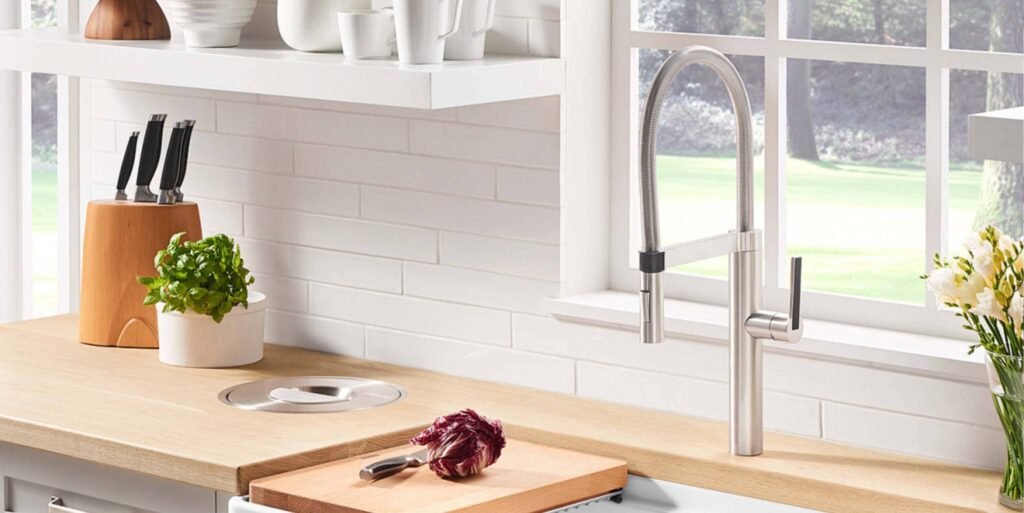
1. What Makes Brass Faucets So Durable?
Brass’s unique metallurgical composition gives it a natural resistance to corrosion and mineral buildup. Unlike cheaper metals, it does not easily rust or crack when exposed to water, humidity, or varying temperatures. This makes brass faucets especially suitable for environments such as kitchens, hotels, and public bathrooms, where reliability is critical.
The density of brass also gives faucets a solid, premium feel. A brass faucet tends to be heavier, indicating quality and longevity — two features professional installers and distributors often look for when selecting high-end fixtures.
2. Lead-Free Brass and International Standards
Historically, brass contained small amounts of lead to improve machinability. However, global standards have evolved to ensure consumer safety. Today, most manufacturers comply with lead-free regulations such as:
- NOM-012-CONAGUA-2021(Mexico)
- NSF/ANSI 61(United States)
- AB1953(California, USA)
These standards limit the lead content to less than 0.25%, ensuring that brass faucets are safe for drinking water applications. Distributors and project buyers should always verify that their suppliers meet these certifications, especially when exporting to regulated markets.
3. Manufacturing Process of Brass Faucets
The production of brass faucets involves multiple precision steps — from raw material casting to machining, polishing, and plating. Brass’s versatility makes it ideal for both forging (for strength) and casting (for complex shapes).
- Forged brass faucets: High strength, excellent pressure resistance, and consistent structure.
- Cast brass faucets: Cost-effective and suitable for decorative designs.
This flexibility allows manufacturers to tailor the process to the buyer’s requirements — whether the goal is a heavy-duty commercial tap or a decorative residential model.
4. Advantages of Brass Faucets
Advantage | Description |
Corrosion Resistance | Brass naturally resists rust, making it ideal for humid or coastal environments. |
Durability | Lifespan of 20–30 years with proper maintenance. |
Machinability | Easy to shape and polish for OEM customization. |
Aesthetic Flexibility | Supports a wide range of finishes—chrome, brushed nickel, matte black, gold, and antique. |
Repairability | Threads, valves, and joints are easily serviceable. |
A well-manufactured brass faucet not only performs better but also retains its shine and structure for years, providing consistent performance in both residential and commercial use.
5. Disadvantages of Brass Faucets
While brass is widely considered the gold standard, it also comes with certain trade-offs:
- Higher Cost:The raw materials (copper and zinc) are more expensive than zinc alloys or stainless steel alternatives.
- Weight:Brass faucets are heavier, increasing shipping and handling costs for large orders.
- Lead-Free Compliance:Production requires stricter material control, which can slightly raise prices.
For B2B buyers, these factors should be considered when evaluating long-term investment versus upfront cost. In most cases, the added durability of brass faucets justifies the initial expense, especially in premium or high-use installations.
6. Common Finishes for Brass Faucets
The finish applied to a brass faucet not only enhances its appearance but also adds an extra layer of protection. Common finishes include:
- Chrome Finish:Highly reflective, easy to clean, and classic in appearance.
- Brushed Nickel Finish:Subtle shine that hides fingerprints and water spots.
- Matte Black Finish:Modern and stylish, but requires more care (link to Are Matte Black Bathroom Faucets Hard to Keep Clean?).
- PVD Coating:A high-tech, vacuum-applied coating offering superior scratch and corrosion resistance.
- Antique or Brushed Brass:A timeless, elegant option for traditional interiors.
A well-applied finish can extend a faucet’s lifespan by protecting the base brass from oxidation and environmental exposure.
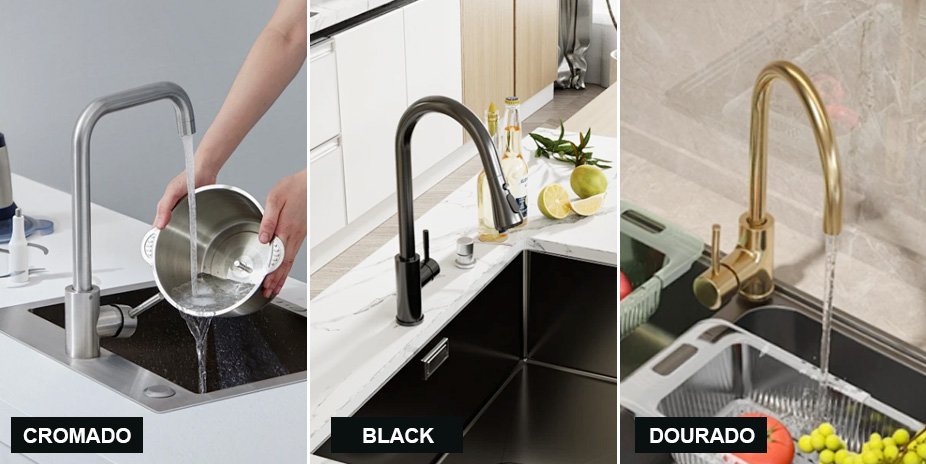
7. Brass Faucets and Corrosion Testing
Professional manufacturers conduct multiple quality tests to ensure brass faucets meet international durability standards. Among these, the salt spray test is the most widely recognized. It exposes faucets to a controlled saline mist to simulate years of exposure to humidity or coastal air.
- 48-hour test:Basic corrosion resistance benchmark.
- 96-hour test:Standard for high-quality faucets.
- 200-hour test:Premium-grade, often required for luxury exports.
These tests confirm the plating’s adhesion, finish integrity, and corrosion protection performance. For distributors sourcing from China or other OEM bases, verifying salt spray test reports is crucial before confirming large-volume orders.

8. The Role of Brass in B2B Projects
In large-scale commercial installations—such as hotels, hospitals, and high-end residences—brass faucets are often specified because of their proven reliability. They perform exceptionally well under varying water conditions and heavy daily usage.
B2B buyers value brass for its consistency: fewer maintenance issues, longer product lifecycles, and reduced after-sales costs. For projects that require long-term stability and customer satisfaction, brass remains the best investment material.
9. Maintenance Tips for Brass Faucets
Maintaining a brass faucet is simple but important.
- Wipe the surface regularly with a soft cloth.
- Avoid harsh cleaners or abrasive pads.
- For unlacquered brass, occasional polishing maintains brightness.
- Always dry the faucet after use to reduce mineral spotting.
Proper maintenance ensures that brass faucets maintain their luxurious appearance and full functionality for decades.
10. Summary: Why Brass Faucets Are Still the Best Choice
In terms of balance between strength, durability, and aesthetic flexibility, brass faucets continue to dominate the market. Their corrosion resistance and proven performance make them the material of choice for both luxury homes and large commercial developments.
While they cost more than zinc or stainless steel options, their reliability and lifespan ensure an excellent return on investment. For professionals and project managers who value quality over short-term savings, brass remains the golden standard of faucet materials.
Stainless Steel Faucets – The Modern, Hygienic Choice (304 vs 201)
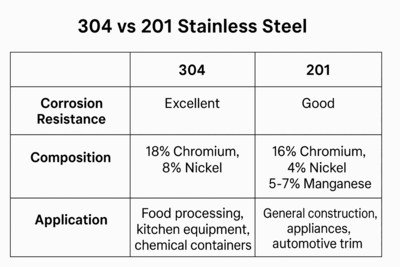
1. The Rise of Stainless Steel Faucets in Modern Plumbing
Stainless steel faucets have become a dominant choice in modern homes and commercial spaces due to their combination of hygiene, durability, and sleek appearance. These faucets provide a balance between design and function, which makes them appealing to architects, interior designers, and B2B buyers alike. As consumers increasingly demand long-lasting and safe water solutions, stainless steel has emerged as one of the most trusted faucet materials.
Unlike coated or plated options, stainless steel faucets are solid throughout, offering corrosion resistance that comes from within the metal itself. This characteristic makes them particularly valuable in humid environments such as bathrooms, kitchens, and coastal regions. For procurement professionals, understanding the different grades of stainless steel—especially 304 vs 201—is key to making informed purchasing decisions.
2. What Makes Stainless Steel Unique Among Faucet Materials
Stainless steel is an iron-based alloy that contains a minimum of 10.5% chromium, which forms a protective oxide layer on the surface. This layer prevents rust and oxidation, giving stainless steel its characteristic durability and luster. In faucet manufacturing, the most common stainless grades are 304 and 201, both known for their strength and resistance to wear.
Compared to brass faucets and zinc faucets, stainless steel faucets stand out for their modern aesthetic and hygienic surface. They do not require plating, so there is no risk of the surface layer peeling or fading over time. This makes them ideal for high-end kitchens and public facilities where cleanliness and appearance must be maintained daily.
From a manufacturing standpoint, stainless steel’s strength also allows for thin-walled designs, enabling lighter yet more robust faucet bodies. However, machining stainless steel requires specialized equipment, which can slightly increase production costs. Despite this, the long-term value offered by stainless steel faucets justifies their growing popularity in both residential and commercial markets.
3. 304 Stainless Steel Faucets – The Industry Standard for Quality
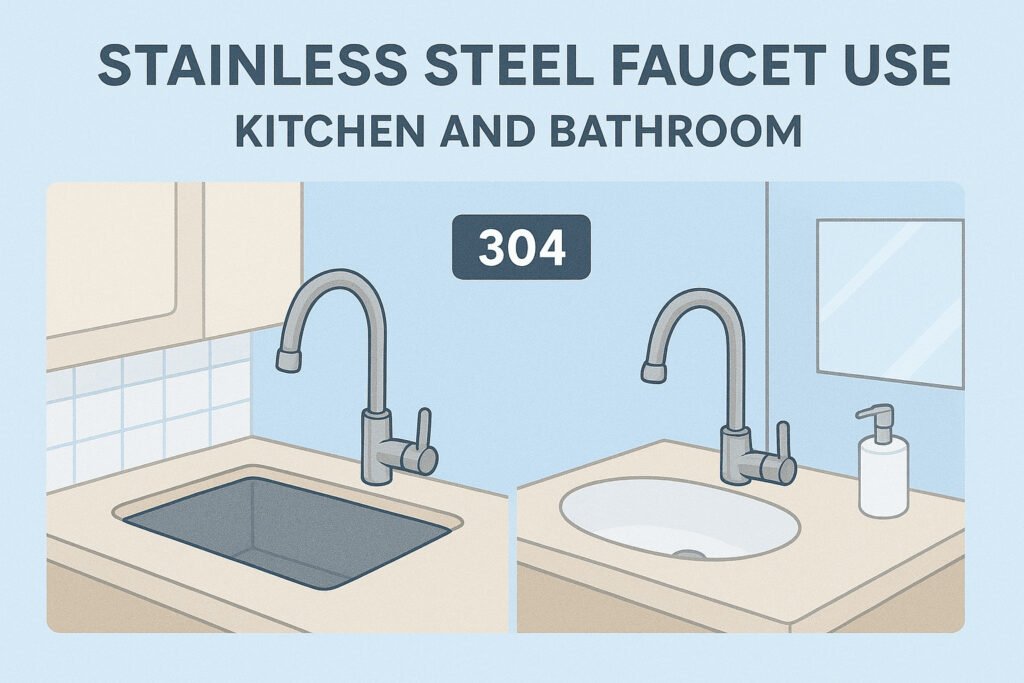
Among all grades, 304 stainless steel is considered the benchmark for faucet manufacturing. It contains around 18% chromium and 8% nickel, which together enhance corrosion resistance and surface brightness. The presence of nickel also gives 304 stainless steel a smoother texture, allowing manufacturers to achieve mirror-polished or brushed finishes that resist stains and fingerprints.
For B2B clients, 304 stainless steel faucets offer excellent value for long-term projects such as hotels, hospitals, and luxury residences. They are particularly suitable for areas exposed to moisture and varying temperatures, such as shower rooms or outdoor sinks. In addition, 304 stainless steel is non-toxic and lead-free, aligning with modern safety and sustainability standards.
One major advantage of 304 stainless steel faucets is their easy maintenance. Routine cleaning with mild soap and water is enough to preserve their shine, making them a preferred choice for clients who seek low-maintenance solutions. When properly maintained, 304 faucets can retain their original appearance for over 10 years with minimal degradation.
4. 201 Stainless Steel Faucets – A Cost-Effective Alternative
In contrast, 201 stainless steel was developed as a more economical alternative to 304. It contains less nickel (3–5%) and higher amounts of manganese, which reduces production costs while maintaining a similar look.
Although 201 stainless steel faucets may appear identical to 304 at first glance, their internal composition affects their performance over time.
The main limitation of 201 stainless steel faucets is their lower corrosion resistance. In humid or salty environments, such as bathrooms or coastal areas, 201 steel may develop surface rust after prolonged exposure. This makes it better suited for indoor applications with limited water contact, such as powder room faucets or decorative fixtures.
However, 201 stainless steel faucets are still popular in certain markets because of their budget-friendly pricing. For developers or wholesalers seeking competitive pricing without compromising visual quality, 201 faucets can be an acceptable choice when used in the right setting.
For OEM projects, 201 stainless steel can also be polished or brushed for a high-end appearance, giving flexibility in product positioning while maintaining affordability.
5. Key Differences Between 304 and 201 Stainless Steel Faucets
Understanding the distinction between 304 vs 201 stainless steel faucets helps buyers balance cost and performance.
While both materials share a similar appearance, their physical and chemical properties vary significantly.
- Composition and Durability:
304 contains higher nickel and chromium levels, offering stronger resistance to corrosion and heat. 201’s increased manganese content makes it harder but more prone to oxidation. - Application Environments:
304 stainless steel faucets are ideal for areas with high humidity or temperature fluctuations, including kitchens and outdoor spaces. 201, meanwhile, should be limited to indoor or decorative applications. - Price and Value:
201 stainless steel faucets are generally 20–30% cheaperthan 304 models, making them attractive for budget-conscious buyers. However, the maintenance cost and shorter lifespan of 201 often balance out the initial savings. - Aesthetic and Surface Finish:
Both grades can achieve the same surface polish, but 304 retains its luster longer and resists pitting or discoloration even after years of use.
For professional buyers, the right choice depends on project requirements. In high-end residential or commercial installations, 304 stainless steel faucets are almost always recommended. In contrast, 201 stainless steel faucets serve as practical solutions for entry-level or decorative lines.
6. Sustainability and Health Benefits of Stainless Steel Faucets
One of the greatest advantages of stainless steel faucets is their environmental sustainability. Stainless steel is 100% recyclable, and its production generates less waste compared to other materials like brass or zinc. In large-scale OEM manufacturing, this aligns with the global trend toward eco-friendly plumbing components.
Stainless steel is also lead-free, which ensures that water flowing through the faucet remains safe for consumption. This is especially important in markets where regulations—such as NOM-012-CONAGUA-2021 in Mexico or NSF/ANSI 61 in North America—demand strict limits on heavy metals in water-contact materials.
Furthermore, the smooth surface of stainless steel prevents bacteria buildup, making it a hygienic choice for healthcare facilities, schools, and kitchens. These properties contribute to its growing reputation as a material that supports both health and sustainability goals in modern architecture.
7. Identifying Genuine Stainless Steel Faucets
For procurement managers and distributors, verifying stainless steel authenticity is essential. The visual similarity between 304 and 201 makes it difficult to distinguish them without testing.
Several practical methods can help identify the grade of stainless steel used in a faucet:
- Magnet Test:304 stainless steel is non-magnetic, while 201 is slightly magnetic.
- Chemical Spot Test:Applying a few drops of copper sulfate solution can reveal nickel presence—304 will resist staining, whereas 201 may show discoloration.
- Manufacturer Documentation:Reputable suppliers should provide grade certificates or test reports verifying the material composition.
- Corrosion Observation:If small rust spots appear after exposure to moisture, the faucet likely contains 201 steel or a lower-grade substitute.
In the B2B supply chain, ensuring accurate material verification builds trust and prevents warranty disputes. Many importers and wholesalers now include random third-party inspections to confirm the use of 304 stainless steel before shipment.
8. Maintenance and Cleaning Recommendations
Although stainless steel faucets are low maintenance, proper care ensures a longer lifespan and cleaner appearance.
Daily wiping with a soft cloth prevents water stains and keeps the faucet shining. For deeper cleaning, a mixture of baking soda and vinegar effectively removes calcium buildup without scratching the surface.
Harsh chemicals or steel wool should be avoided, as they may damage the passive oxide layer that provides corrosion resistance.
A monthly inspection of faucet joints and aerators is also recommended to prevent clogging and maintain water flow performance.
Readers interested in more detailed cleaning techniques can refer to related guides such as “Are Matte Black Bathroom Faucets Hard to Keep Clean?” for universal faucet maintenance methods. By following consistent cleaning routines, even high-traffic commercial installations can maintain their appearance for years.
9. Summary – Why Stainless Steel Faucets Remain the Modern Standard
Stainless steel faucets represent the ideal balance between aesthetics, hygiene, and durability. Among available grades, 304 stainless steel faucets stand as the professional’s choice for long-term use, while 201 stainless steel faucets provide an accessible alternative for cost-sensitive projects.
The continued evolution of stainless steel technology promises even greater corrosion resistance and design versatility in the future. For wholesalers, project contractors, and OEM manufacturers, understanding these material nuances ensures better decision-making, reduced maintenance costs, and enhanced customer satisfaction.
In today’s competitive plumbing market, choosing the right stainless steel faucet isn’t just about appearance—it’s about ensuring safety, longevity, and trust in every drop of water delivered.
Zinc Faucets – Affordable but Compromised
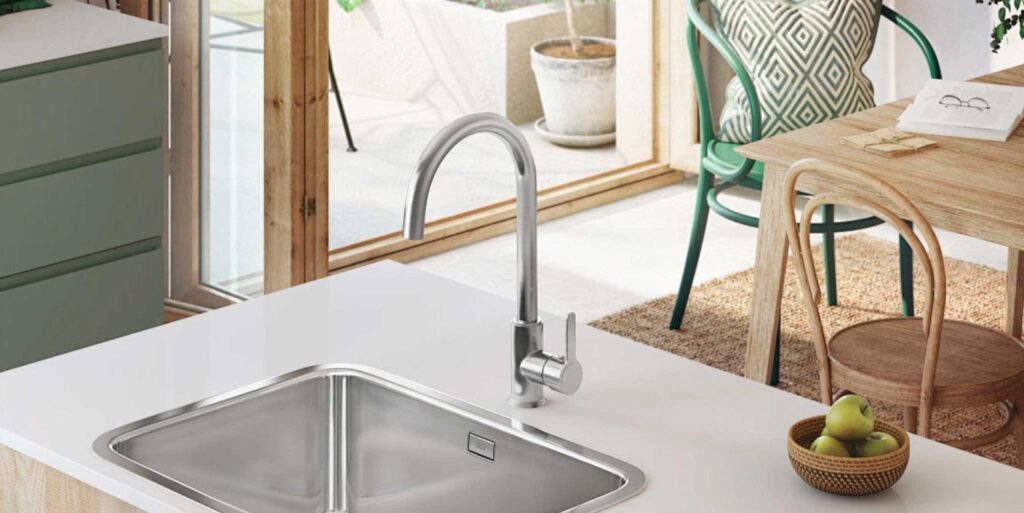
1. Introduction – Understanding the Role of Zinc Faucets
While brass and stainless steel dominate the premium faucet market, zinc faucets occupy an important space in the budget and decorative segments. They are widely used in projects where cost control is critical, such as entry-level residential units, temporary installations, or decorative replacements.
For B2B buyers, zinc faucets provide a low-cost solution, but understanding their limitations is crucial to ensure that product expectations align with performance. Unlike brass or stainless steel, zinc is more susceptible to corrosion and wear, which affects long-term durability.
2. Composition and Properties of Zinc Faucets
Zinc faucets are typically made from zinc alloy, often combined with small amounts of aluminum, copper, or magnesium to improve strength and casting performance. The material is lightweight, easy to mold, and offers a smooth surface suitable for plating or painting.
However, zinc’s corrosion resistance is limited compared to brass and stainless steel. Prolonged exposure to water, humidity, or acidic conditions can cause the surface to oxidize or discolor over time. Therefore, zinc faucets are more suitable for indoor or low-moisture environments.
3. Advantages of Zinc Faucets
Despite their limitations, zinc faucets offer certain advantages that make them appealing for specific applications:
Advantage | Description |
Low Cost | Zinc is significantly cheaper than brass or stainless steel, reducing project costs. |
Lightweight | Easier to handle and transport, lowering shipping and installation effort. |
Moldability | Can be easily cast into intricate shapes, supporting decorative designs. |
Surface Finish Flexibility | Supports chrome, matte black, brushed nickel, and other plated finishes. |
Short-Term Projects | Ideal for rentals, showrooms, or temporary installations where long-term durability is less critical. |
For B2B clients targeting volume projects with limited budgets, zinc faucets can be an effective choice when used in the right context.
4. Limitations and Risks of Zinc Faucets
While zinc faucets offer affordability, they come with trade-offs that must be considered:
- Shorter Lifespan:Typically 5–10 years under normal use, significantly less than brass or stainless steel.
- Corrosion Susceptibility:Zinc corrodes faster, particularly in high-humidity areas or with hard water.
- Structural Weakness:Lightweight zinc can warp under high water pressure or impact.
- Maintenance Requirements:Plated finishes can wear off more quickly, exposing the base metal to oxidation.
For professional buyers, these limitations mean zinc faucets are not ideal for high-use commercial environments. Choosing zinc without understanding the application context can lead to customer complaints or warranty claims.
5. Zinc Faucet Manufacturing Process
The production of zinc faucets relies heavily on die casting, which allows rapid and precise shaping of faucet components. After casting, the faucets typically undergo surface treatment:
- Polishing:Smooths the surface and prepares it for plating.
- Plating:Chrome, nickel, or matte finishes improve appearance and provide minor corrosion protection.
- Painting:For decorative zinc faucets, powder coating or enamel finishes offer color options.
The low melting point of zinc simplifies the casting process and reduces energy consumption, which can be attractive for large-scale OEM manufacturing. However, over-thinning walls or over-polishing can compromise structural integrity.
6. Recommended Applications for Zinc Faucets
Zinc faucets are most appropriate for cost-sensitive or decorative projects:
- Entry-level residential units:Affordable faucets for short-term installations.
- Rental properties:Provides functionality without high replacement costs.
- Decorative projects:Intricate designs or colorful finishes achievable with zinc casting.
- Showrooms and sample displays:Lightweight and visually appealing, ideal for demonstration purposes.
By matching the faucet material to project requirements, buyers can maintain budget control without significantly compromising aesthetics.
7. Maintenance Tips for Zinc Faucets
Although zinc faucets are generally low-maintenance, proper care extends their service life:
- Avoid prolonged exposure to water or moisture.
- Wipe dry after each use to prevent surface oxidation.
- Avoid abrasive cleaners or pads that can remove plating.
- Inspect periodically for corrosion, especially around joints and aerators.
Following these basic steps can help zinc faucets maintain their finish and function longer, ensuring better customer satisfaction.
8. Comparison with Brass and Stainless Steel Faucets
Zinc faucets occupy a lower tier in the hierarchy of faucet materials:
Material | Lifespan | Corrosion Resistance | Cost | Typical Use |
Brass | 20–30 years | Excellent | $$$ | High-end residential, commercial |
Stainless Steel (304) | 15–20 years | Very Good | $$ | Kitchens, hotels, hospitals |
Zinc | 5–10 years | Moderate | $ | Budget, decorative, temporary projects |
This comparison helps B2B buyers understand the trade-offs between cost, durability, and application environment. While zinc faucets are not suitable for heavy-use or long-term projects, they remain a practical option for specific needs.
9. Summary – When to Choose Zinc Faucets
Zinc faucets serve a clear purpose in the marketplace: offering affordability and flexibility for low-budget or decorative projects. They are lightweight, easy to mold, and visually versatile, but their shorter lifespan and susceptibility to corrosion limit their suitability for high-use applications.
For B2B buyers, zinc faucets are a strategic choice when project requirements prioritize upfront cost over long-term durability. Understanding their strengths and weaknesses ensures better project planning, reduces warranty risks, and maintains customer satisfaction.
Internal Link
Comparing Faucet Materials – Choosing the Best for Your Projects

1. Introduction – Why Material Comparison Matters
Selecting the right faucet material is one of the most critical decisions for developers, distributors, and project managers. The choice directly impacts durability, maintenance cost, aesthetic appeal, and customer satisfaction. For B2B buyers, understanding the differences between brass faucets, stainless steel faucets (304 vs 201), and zinc faucets helps ensure projects are delivered on time, on budget, and with long-term reliability.
While design and finish are important, the underlying material ultimately determines performance. A faucet that looks premium but is made from a lower-quality material may fail sooner, leading to complaints, replacements, and additional costs. Conversely, choosing the right material upfront minimizes risks and improves ROI over the product lifecycle.
2. Brass Faucets – Long-Term Durability
Brass remains the gold standard for long-lasting faucets. Its corrosion resistance, solid weight, and machinability make it ideal for high-traffic environments and premium installations.
- Strengths:Lifespan of 20–30 years, excellent corrosion resistance, easily repairable, and supports a wide variety of finishes (chrome, brushed nickel, matte black, antique).
- Limitations:Higher upfront cost, heavier weight, and requires strict lead-free compliance for safe water use.
For B2B buyers, brass faucets are recommended for hotels, hospitals, high-end residences, and commercial spaces where durability and low maintenance are critical.
3. Stainless Steel Faucets – Hygiene and Modern Aesthetic
Stainless steel faucets, particularly 304 grade, combine modern design, hygiene, and corrosion resistance. They are ideal for kitchens, bathrooms, and commercial areas requiring frequent cleaning.
- 304 Stainless Steel:Offers superior corrosion resistance, non-toxic and lead-free, retains shine for years, suitable for high-humidity environments.
- 201 Stainless Steel:Cost-effective alternative, lower corrosion resistance, best for indoor or low-moisture applications.
Stainless steel faucets are lighter than brass, easier to maintain, and often preferred in projects emphasizing sleek, modern aesthetics. They provide a good balance between performance and cost for medium- to high-end applications.
4. Zinc Faucets – Budget-Friendly but Limited
Zinc faucets are popular in low-budget, decorative, or temporary applications. They offer affordability and flexibility in shape and finish but compromise durability.
- Advantages:Low cost, lightweight, supports intricate designs and plating finishes.
- Limitations:Lifespan of 5–10 years, prone to corrosion, structural weakness under high water pressure.
Zinc faucets are suitable for rental properties, showrooms, or entry-level housing, but are not recommended for high-use or long-term installations.
5. Head-to-Head Material Comparison
Material | Durability | Corrosion Resistance | Maintenance | Cost | Typical Applications |
Brass | 20–30 years | Excellent | Easy, repairable | $$$ | Hotels, hospitals, premium homes |
Stainless Steel 304 | 15–20 years | Very Good | Low, easy to clean | $$ | Kitchens, commercial, high-humidity |
Stainless Steel 201 | 10–15 years | Moderate | Moderate | $ | Budget indoor applications |
Zinc | 5–10 years | Fair | Moderate | $ | Decorative, temporary, rental properties |
This table illustrates how material choice aligns with project goals. B2B buyers can weigh upfront costs against long-term durability to make informed decisions that minimize replacement and maintenance costs.
6. Selecting Materials for Different Project Types
- High-End Residential Projects:
- Recommended: Brass or 304 stainless steel.
- Reason: Long lifespan, corrosion resistance, premium aesthetic, low maintenance.
- Commercial & Public Spaces:
- Recommended: Brass or 304 stainless steel.
- Reason: Frequent use, high hygiene standards, durability under heavy traffic.
- Budget or Decorative Projects:
- Recommended: 201 stainless steel or zinc.
- Reason: Lower cost, adequate performance for short-term or low-use scenarios.
- Coastal or High-Humidity Environments:
- Recommended: 304 stainless steel or brass.
- Reason: Superior corrosion resistance to salt, moisture, and temperature fluctuations.
This framework helps B2B buyers match material selection with project requirements while balancing cost, durability, and performance.
7. Maintenance Considerations Across Materials
Understanding maintenance needs is crucial for longevity:
- Brass Faucets:Minimal cleaning required; polish occasionally for unlacquered finishes.
- Stainless Steel Faucets:Low maintenance; wipe regularly to remove water spots; avoid abrasive cleaners.
- Zinc Faucets:Require careful cleaning; dry after use to prevent corrosion; avoid harsh chemicals.
Choosing the right material reduces both maintenance workload and operational costs, especially in commercial or high-use settings.
8. Material Selection Tips for B2B Buyers
- Verify Material Certifications:Ensure lead-free compliance (e.g., NOM-012-CONAGUA, NSF/ANSI 61).
- Consider Project Lifecycle:Factor in expected lifespan and replacement frequency.
- Match Material to Environment:High-humidity or heavy-use areas require more durable materials.
- Balance Cost vs Performance:Low-cost materials like zinc may save money initially but incur higher long-term costs.
- Check Finish Quality:Even the best material can fail prematurely if the plating or coating is poor.
Applying these principles ensures smart purchasing decisions and reduces warranty risks.
9. Summary – Making the Right Choice
Choosing the right faucet material requires balancing durability, cost, maintenance, and aesthetic appeal.
- Brass Faucets:Longest lifespan, excellent corrosion resistance, ideal for premium and high-use projects.
- 304 Stainless Steel Faucets:Modern, hygienic, suitable for kitchens and commercial areas.
- 201 Stainless Steel Faucets:Budget alternative, suitable for indoor or low-use areas.
- Zinc Faucets:Affordable but short-lived, best for decorative or temporary projects.
For B2B buyers, informed material selection reduces long-term costs, minimizes complaints, and strengthens supplier-client trust. By understanding the strengths and limitations of each material, professionals can ensure that every faucet installation meets both functional and aesthetic requirements.
Maintenance, Installation, and Long-Term Care Tips
1. Introduction – Why Proper Care Matters
Proper installation and maintenance of faucets are critical for ensuring long-term performance and customer satisfaction. For B2B buyers and project managers, even premium materials like brass or 304 stainless steel can fail prematurely if installation is poor or maintenance is neglected.
Maintenance, cleaning, and installation best practices not only extend faucet lifespan but also reduce warranty claims, minimize operational costs, and protect brand reputation for suppliers and distributors.
2. Installation Best Practices
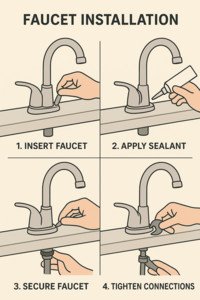
The foundation of long-term faucet performance begins with correct installation:
- Check Water Pressure:Ensure the water supply is within recommended PSI limits to prevent stress on joints and components.
- Use Proper Seals:Teflon tape or rubber washers should be applied to threaded connections to prevent leaks.
- Secure Mounting:Faucets must be firmly attached to sinks or countertops to avoid wobbling or loosening over time.
4. Follow Manufacturer Guidelines:Each faucet model has specific torque, alignment, and assembly instructions.
5. Inspect Supply Lines:Flexible hoses or rigid piping must be properly connected, leak-free, and compatible with the faucet material.
Professional installation reduces risks associated with premature leaks, surface damage, and internal corrosion.
3. Daily and Weekly Maintenance
Routine cleaning and inspection prevent common problems and preserve faucet appearance:
- Daily Wiping:A soft cloth removes water spots and prevents mineral buildup, especially on stainless steel or matte finishes.
- Weekly Inspection:Check for minor leaks, loose handles, or corrosion. Early detection avoids costly repairs.
- Aerator Cleaning:Removing and cleaning aerators prevents clogging and maintains water flow.
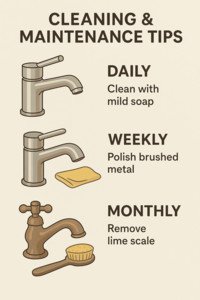
- Avoid Abrasive Cleaners:Harsh chemicals or scrub pads can damage finishes, particularly on plated zinc or brass faucets.
For high-traffic installations, implementing a maintenance schedule ensures longevity and customer satisfaction.
4. Monthly and Quarterly Checks
Periodic checks complement daily maintenance for commercial and residential projects:
- Corrosion Assessment:Inspect brass and stainless steel faucets for early signs of rust or pitting, especially near joints or under high humidity.
- Finish Inspection:Ensure matte, brushed, or chrome finishes remain intact; re-polish or touch up if necessary.
- Valve Performance:Test handles and cartridges for smooth operation and replace worn components promptly.
- Leak Detection:Check under sinks and behind faucets for hidden leaks, which can cause water damage over time.
These checks are particularly important for high-use environments like hotels, restaurants, and public facilities, where daily wear is significant.
5. Cleaning Techniques for Different Materials
Each faucet material requires a tailored cleaning approach to maximize lifespan and maintain aesthetics:
- Brass Faucets:
- Use mild soap and water.
- Unlacquered finishes may be polished with a soft cloth for shine.
- Avoid acidic cleaners that can tarnish brass.
- Stainless Steel Faucets:
- Wipe with a microfiber cloth to remove fingerprints and water spots.
- Use diluted vinegar or baking soda for mineral buildup.
- Avoid steel wool, which can scratch the surface.
- Zinc Faucets:
- Wipe dry after each use to prevent oxidation.
- Avoid harsh chemical cleaners and abrasive pads.
- Regularly inspect plating for wear.
These approaches directly relate to high-traffic areas or decorative finishes, ensuring faucets retain their original look for years.
6. Troubleshooting Common Faucet Issues
Understanding and addressing common issues improves client satisfaction and reduces replacement costs:
- Leaking Handles or Cartridges:Often caused by worn O-rings or misaligned cartridges. Replace parts promptly.
- Low Water Flow:Usually due to clogged aerators; cleaning restores performance.

3. Surface Discoloration:Can occur on zinc or brass faucets due to oxidation; polishing and routine cleaning mitigate it.
4. Loose Mounting:Tighten connections to prevent wobbling and joint stress.
Proactive troubleshooting also helps distributors provide technical support, which enhances professional credibility.
7. Linking Maintenance to Product Longevity
Material choice and maintenance are intertwined:
- Brass Faucets:Even with premium materials, neglecting cleaning accelerates tarnish.
- 304 Stainless Steel Faucets:Benefits from wiping but remains highly resistant to corrosion.
- 201 Stainless Steel or Zinc Faucets:Require more attention; failure to maintain can lead to rust, leaks, or surface damage.
For B2B buyers, maintenance planning is as important as material selection. Providing clients with clear care guidelines reduces long-term issues and strengthens supplier-client relationships.
Good Guide:
- Are Matte Black Bathroom Faucets Hard to Keep Clean?– Cleaning tips for specialty finishes.
- How to Fix a Leaky Faucet Handle Easy– Step-by-step repair guidance.
- 5 Tips to Clean Bathtub Jets Easily and Quickly– Extended cleaning strategies for connected plumbing.
- Faucet Leaking Causes and Solutions– Troubleshooting leaks across materials.




